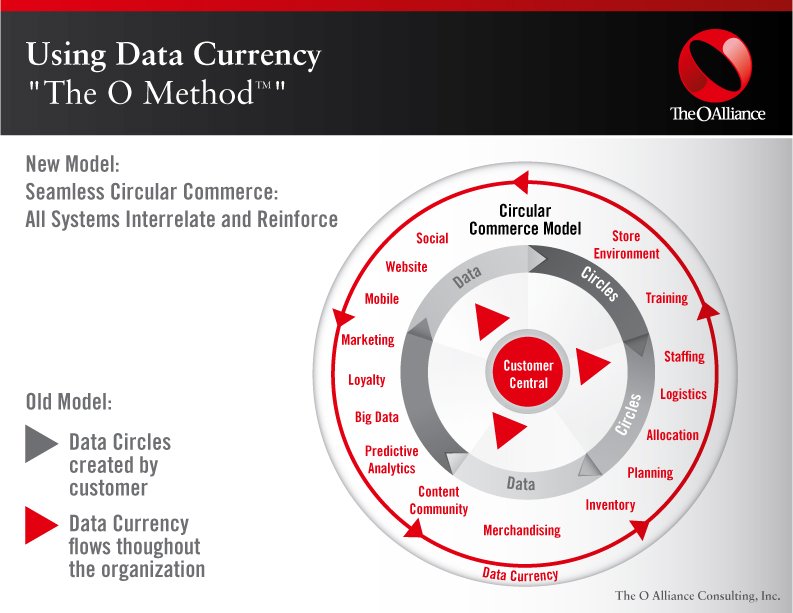Commentary
Retail Reinvention Was Never About Omni-channel
Sep 20, 2016
RETAIL REINVENTION WAS NEVER ABOUT OMNI-CHANNEL

By Andrea Weiss
As retailers continue to reel from yet another quarter of declining in-store traffic and challenging sales, a small, but growing group of retailers are waking up to the reality that truly re-inventing retail shopping experiences will require more than buzz words, “shiny object” technology, new digital job titles, or even innovation labs. This awakening is rooted in a retail fundamental – that everything is about the customers saying “I’ll take it!” And a retail organization focused on anything except the customer is destined to fail.
WRONG FOCUS: NO CHANNEL EVER TRUMPS THE CUSTOMER
Any business growth model which is dependent on a narrow perspective has inherit weakness. A blind side always exists. Whether it is making a business discipline “king” or driving the company with a functional capability, organizations have allowed the means to get ahead of the end. This pattern of a singular internal looking focus…whether it is on product, price, brand or the supply chain, is not enough in today’s connected environment. This is particularly true of the popular Omni-channel strategy.
Unintentionally, the overused moniker “Omni-channel” sent damaging organizational signals; reinforcing existing silos and even creating new ones, just when the industry required a totally opposite approach to meeting customer needs. And words really do matter in leadership when shaping future strategy and execution. It seemed that the industry got lost in a maze of technology and digital marketing solutions, applying many to an old organizational hierarchy built for independent channels. Many companies even built duplicitous capabilities surrounding the buying, marketing and distribution of product and information, only to later merge the organizations amid headcount reductions to curtail mounting overhead costs. As retail needed to align all functions to deliver customer engagement, service and unique brand experience, the words got in the way.
LOST IN TRANSLATION: IT WAS ALWAYS ABOUT SEAMLESS CUSTOMER EXPERIENCE
The origination of the Omni-channel buzz word goes back to 2002, when Brian Walker, now the Chief Strategy Officer at SAP Hybris, and a leading thinker on the topic of digital integration, gave a magazine interview. Brian shared his views describing a connected shopping experience, with all channels acting as one. While the phrase he used was “seamless Omni-channel experience,” the term picked up by the media put the emphasis on one channel…. And left out the vital word – seamless.
And thus the charge began to create e-commerce like shopping experiences in the stores. And while the marriage of digital commerce to physical stores was necessary for a customer to have an aligned experience, much was lost in translation in the execution of the Omni-channel experience. Organizations tried to build the new seamless future around the existing channels which they already operated and understood. As an example, retailers seeking to leverage inventory attempted e-commerce fulfillment from stores with varying degrees of success and many unintended consequences. From inaccurate inventory, to operational snafus, unhappy workforces, to poor customer experiences with inconsistent packaging and shipping standards; turning the store into a fulfillment center was not what was intended for a frictionless customer experience. But it is one of the outcomes of the Omni-channel approach driving strategy.
CLOSER TO THE CUSTOMER
Customers shop for many reasons – from convenience to price, to experience – but the fact is most customers do not think or intentionally shop by channels. While some delivery methods may serve a particular shopping rationale better than others, the success of any retail channel is to service and delight the customer. Removing friction from any part of the shopping transaction and replacing it with service, experience, information and efficiency can lead to both successful commerce and customer loyalty.
If brick and mortar stores take only one lesson away from digital giant, Amazon; it would not be about the e-commerce channel, logistics, operations, or even technology. The powerful lesson of Amazon is its relentless focus on the customer. Amazon, who actually never sees their customer, has a significantly more intimate relationship with those they serve than most traditional retailers who greet their customers daily. The ability to be closer to the customer requires a totally different approach than one driven by channel. There is not a mention of Omni-channel in the Amazon strategy. The Amazon organization, now with multiple lines of business, operates surprisingly flat and synergistically. Data integration allows all customer contact to fuel this seamless approach. Amazon has mastered data analytics to insure that everyone they serve feels like Amazon is their store. And Amazon will soon be delighting even more customers, as they bring this seamless data rich capability to an Amazon store near you!
NEW CIRCULAR APPROACH REQUIRED
It is time to shift the conversation from a channel-driven approach to a more holistic one. Becoming channel agnostic is critical to future survival, as is recognizing the strengths and weaknesses of all customer touchpoints. A retailer can start the true re-invention journey by abandoning the Omni-channel nomenclature and embracing a move towards a customer-centric organization.
The physical nature of stores represents one of the greatest areas of opportunity and for improvement. The visual, tactile and human interfaces with the customer is a key competitive advantage of the store experience over digital and when done at levels of excellence, will always outperform e-commerce. Surprisingly, many lost sight of the importance of the store in the race to build an Omni-channel backend to compete with the less profitable e-commerce channel. Renewed attention to store design, shopkeeping, service, training and operational excellence are all required to distinguish stores. And a data rich and technology-enabled store experience will bring the best of both worlds together.
In addition to developing a new vocabulary and regaining attention to stores, retailers require new methods of working to create this seamless shopping experience. The organization of the future will not be a traditional hierarchy, rather more team-based and circular in nature. Flattening the organization and building cross functional work teams will also speed integration and reduce old siloed behaviors.
Leading organizations will introduce a new unifying concept to the organization, called Data Currency and build literacy in the use of the company’s data. And as the customer moves to the center of attention, creating the data that drives decision-making, the only “king” in the organization of the future – will be the customer.
Andrea Weiss has had a thirty year career in senior leadership with some of the world’s foremost retailers. She is the founder of The O Alliance, LLC and CEO of Retail Consulting Inc., a global consulting practice focused on the retail, e-commerce and consumer sector. As part of her practice work, Ms. Weiss has provided both consulting services, operating expertise, and has the unique ability to step into a business as a C-level executive; working with companies such as Palacio de Hierro (Mexico City), and Grupo Cortefiel, a major Spanish retailer. Ms. Weiss is also an advisor to a number of early stage e-commerce and digital businesses, as well as leading private equity firms. She was previously President of dELiA*s, GUESS, and EVP, Chief Stores Officer of L Brands. Earlier in her career, she was SVP at ANN TAYLOR and Director of Merchandising for The Walt Disney Company. Ms. Weiss holds a Masters of Administrative Science from The Johns Hopkins University and a Bachelor of Fine Arts from Virginia Commonwealth University. She also completed post-graduate studies at Harvard Business School and The Kellogg School at Northwestern University. In 2016, Ms. Weiss was honored by the National Association of Corporate Directors as one of America’s Top 100 Board Members. Contact Andrea at aweiss@theoalliance.com.
